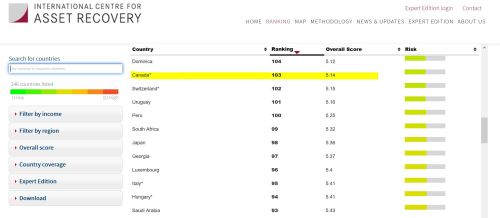Last week, the Basel Institute on Governance released its 2020 edition of the Basel AML Index. And what a surprise it was to discover that the country identified as having the lowest risk of money laundering was Estonia when we know the country appeared to be a Russian laundromat not so long ago. Indeed, everyone remembers one of the biggest money laundering scandals in Europe, namely the $223 billion of suspicious transactions that flowed through Danske Bank’s Estonian branch for 8 years. Tallinn’s performance in the Basel AML Index might shine a light on the limits of static indexes in the risk assessment of money laundering and financial crimes in general.
The Basel AML Index is a composite index, which means it’s built based on different data sources, most of which are updated annually, including Transparency International, the World Bank and the World Economic Forum. Notably, the Basel Institute significantly weighted the crucial role of the FATF Mutual Evaluation Reports in the methodology used to build the Basel AML Index (FATF evaluation makes up 35% of the total risk score) while Tallinn’s most recent FATF Mutual Evaluation was in 2014. Even if the report highlighted the good performance of the Baltic state at that time, we could assume that the recent Swedbank and Danske Bank scandals, along with the suspicious $1.27 trillion in cross-border transactions that have been handled between 2008 and 2017 might have worsened consequently a post-2018 FATF evaluation of the country, and subsequently Estonia’s ranking in the latest Basel AML Index.
According to the Basel Institute, the index “should also form part of a comprehensive, risk-based compliance programme along with additional indicators and procedures”. The holistic picture of money laundering risk aimed by the index could therefore totally be associated with a more dynamic approach, namely Sigma’s Dynamic Country Risk ranking, especially when it comes to exposed regions like the Baltics or Hong Kong currently experiencing regulatory or multilevel changes. Furthermore, those countries are constantly exposed to illicit financial flows coming from abroad (Russia, China in this specific case) due to both the geographic proximity and the high rate of Russian/Chinese residents and non-residents present in those financial hubs.
When exploring Estonia in Sigma’s Dynamic Country Risk ranking, the Baltic state is at the Highest risk of Financial Crime and its riskier than 85% of ranked countries while its Overall Risk Rating is Medium. Recent $1 million fine imposed by the Financial Supervisory Authority to SEB Pank, the revocation of 500 cryptocurrency firms’ licenses in a hasty move to prove its good faith in cracking down money laundering or Estonia’s opposition in June to an EU plan to transfer money laundering scrutiny from national watchdogs to an EU-wide body have surely contributed to worsen Tallinn’s score on Financial Crime. In Bank of Estonia’s own words, “Estonian banks need to develop and improve their Anti-Money Laundering (AML) processes”, along with adopting tougher regulation in the crypto industry as the country might have previously given permits too easily to “God knows what companies”, leading to the money laundering issues we all know.
Although, in a move to transform its image, the tiny Baltic state has taken some regulatory measures to tackle money laundering issues in its banking system, like the launch last year of multiple investigations and checks on different lenders or the ambition expressed this week by the Tax and Customs Board to “extend the list of key national security positions requiring due diligence measures in the fight against money laundering”. The hiring of former FBI director Louis J. Freeh, who, according to OCCRP, was tasked with helping to prove “to U.S authorities that Estonia was a victim in the Danske Bank money laundering scandal” is another proof of Tallinn’s plethoric willpower to show its good faith. All those recent regulatory and reputational developments are examples of dynamic factors that might explain Estonia’s Medium Overall Environment Risk.

This week, the Basel Institute on Governance published the 10th annual edition of the Basel AML Index for 2021, a country risk ranking of money...

Last week theWall Street Journalhighlighted a new, burgeoning money laundering hub.Where is it you ask?

Last week, we reported on the newly released 2020 Basel AML Index and the importance of a more dynamic approach to country risk ratings, and risk in...
